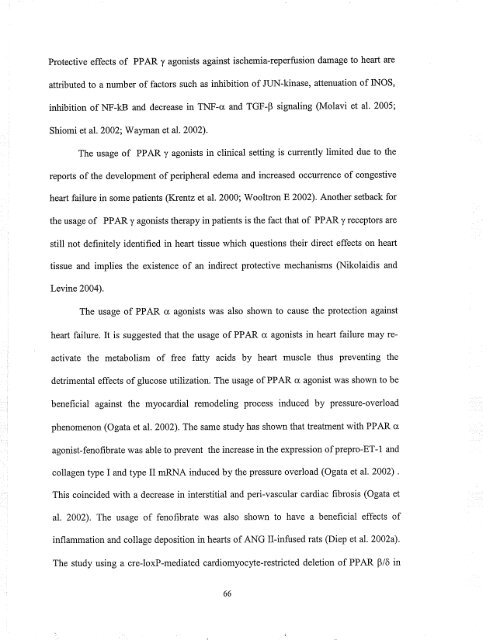il\VOLVEMENT OF RETII\OIC ACID II{ - MSpace at the University of ...
il\VOLVEMENT OF RETII\OIC ACID II{ - MSpace at the University of ...
il\VOLVEMENT OF RETII\OIC ACID II{ - MSpace at the University of ...
Create successful ePaper yourself
Turn your PDF publications into a flip-book with our unique Google optimized e-Paper software.
Protective effects <strong>of</strong> PPAR y agonists against ischemia-reperfusion damage to heart are<br />
<strong>at</strong>tributed to a number <strong>of</strong> factors such as inhibition <strong>of</strong> fUN-kinase, <strong>at</strong>tenu<strong>at</strong>ion <strong>of</strong> INOS,<br />
inhibition <strong>of</strong> NF-kB and decrease in TNF-c¿ and TGF-B signaling (I\4olavi et al. 2005;<br />
Shiomi et al. 2002;'Wayman et al. 2002).<br />
The usage <strong>of</strong> PPAR y agonists in clinical setting is currently limited due to <strong>the</strong><br />
reports <strong>of</strong> <strong>the</strong> development <strong>of</strong> peripheral edema and increased occurrence <strong>of</strong> congestive<br />
heart failure in some p<strong>at</strong>ients (Krentz et al. 2000; Wooltron E 2002). Ano<strong>the</strong>r setback for<br />
<strong>the</strong> usage <strong>of</strong> PPAR y agonists <strong>the</strong>rapy in p<strong>at</strong>ients is <strong>the</strong> fact th<strong>at</strong> <strong>of</strong> PPAR y receptors are<br />
still not definitely identified in heart tissue which questions <strong>the</strong>ir direct effects on heart<br />
tissue and implies <strong>the</strong> existence <strong>of</strong> an indirect protective mechanisms Q.{ikolaidis and<br />
Levine 2004).<br />
The usage <strong>of</strong> PPAR a agonists was also shown to cause <strong>the</strong> protection against<br />
heart failure. It is suggested th<strong>at</strong> <strong>the</strong> usage <strong>of</strong> PPAR cr agonists in heart failure may reactiv<strong>at</strong>e<br />
<strong>the</strong> metabolism <strong>of</strong> free f<strong>at</strong>ty acids by heart muscle thus preventing <strong>the</strong><br />
detrimental effects <strong>of</strong> glucose utiliz<strong>at</strong>ion. The usage <strong>of</strong> PPAR a agonist was shown to be<br />
beneficial against <strong>the</strong> myocardial remodeling process induced by pressure-overload<br />
phenomenon (Og<strong>at</strong>a et aL.2002). The same study has shown th<strong>at</strong> tre<strong>at</strong>ment with PPAR a<br />
agonist-fen<strong>of</strong>ibr<strong>at</strong>e was able to prevent <strong>the</strong> increase in <strong>the</strong> expression <strong>of</strong> prepro-ET-i and<br />
collagen type I and type <strong>II</strong> mRNA induced by <strong>the</strong> pressure overload (Og<strong>at</strong>a et al.2002) .<br />
This coincided with a decrease in interstitial and peri-vascular cardiac fibrosis (Og<strong>at</strong>a et<br />
al. 2002). The usage <strong>of</strong> fen<strong>of</strong>ibr<strong>at</strong>e was also shown to have a benef,rcial effects <strong>of</strong><br />
inflamm<strong>at</strong>ion and collage deposition in hearts <strong>of</strong> ANG Il-infused r<strong>at</strong>s (Diep et al.2002a).<br />
The study using a cre-loxP-medi<strong>at</strong>ed cardiomyocyte-restricted deletion <strong>of</strong> PPAR p/ô in<br />
66







![an unusual bacterial isolate from in partial fulf]lment for the ... - MSpace](https://img.yumpu.com/21942008/1/190x245/an-unusual-bacterial-isolate-from-in-partial-fulflment-for-the-mspace.jpg?quality=85)





![in partial fulfil]ment of the - MSpace - University of Manitoba](https://img.yumpu.com/21941988/1/190x245/in-partial-fulfilment-of-the-mspace-university-of-manitoba.jpg?quality=85)


